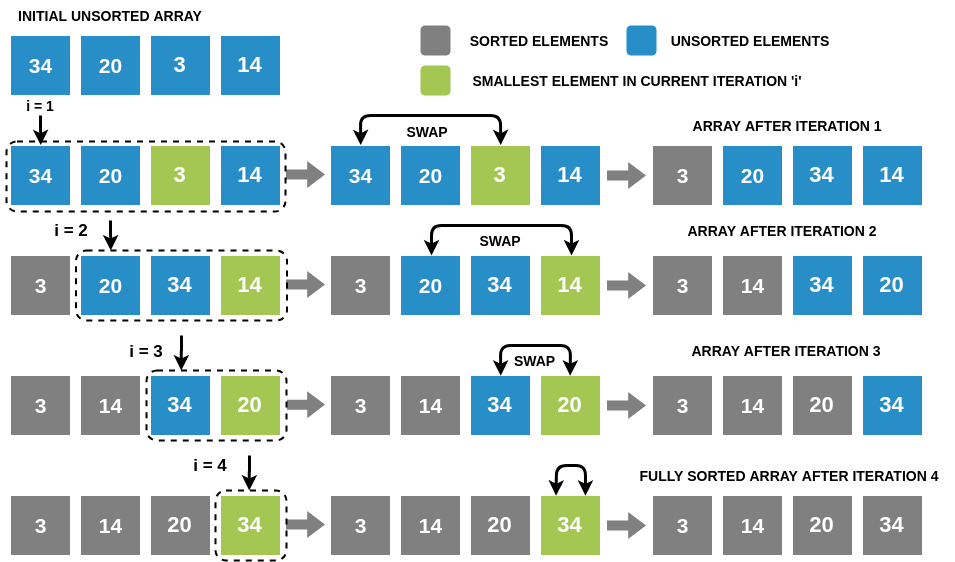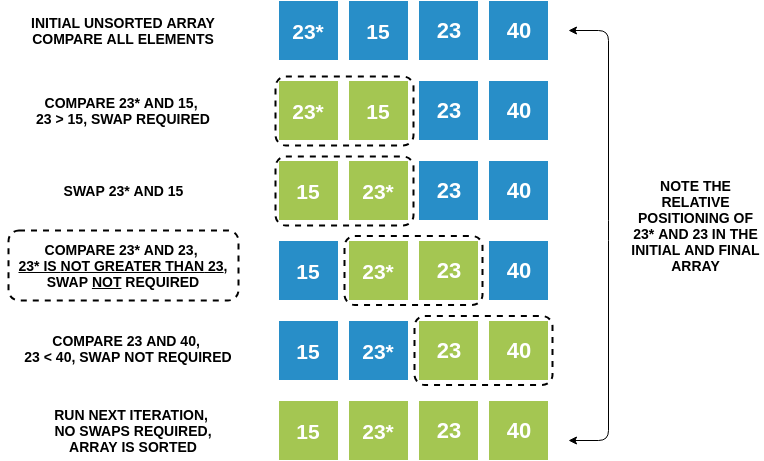
Open-Source Internship opportunity by OpenGenus for programmers. Apply now.
Bubble sort and Selection sort are both comparison-based sorting algorithms which can be differentiated through the methods they use for sorting. But before going through the key differences between them, let's understand how both of these algorithms work.
We have a table of differences further in this article.
Table of contents
- Basics of Bubble Sort
- Basics of Selection Sort
- Key Differences between Bubble Sort and Selection Sort
- Summary
- Test Your Knowledge
- Conclusion
Basics of Bubble Sort
Bubble sort is a comparison-based sorting algorithm that involves making passes over the input array where, in each pass, adjacent elements are swapped if they are not present in the required order (ascending or descending). It keeps on making the passes until the whole array is sorted.
Bubble Sort Algorithm (in ascending order)
- Starting from the first index, compare the first two elements. If the first element is greater than the second element, swap them; else, leave them as it is.
- Now, compare the next two elements. Swap them if they are not in order. This process goes on until the last element.
The first pass is complete — largest element present will be at the end of the array.
- The same process goes on for the remaining passes. After each pass, the largest element among the unsorted elements is placed at the end.
In each pass, the comparison takes place up to the last unsorted element. The array is sorted when all the unsorted elements are placed at their respective correct positions.
Optimized Bubble Sort: If, in a pass, we do not make any swaps, then we don’t need to make any further passes.
Iteration by Iteration Visualization of Bubble Sort

Bubble Sort Code in Java
public static void bubbleSort(int arr[])
{
int n = arr.length;
for (int i = 0; i < n - 1; i++)
for (int j = 0; j < n - i - 1; j++)
if (arr[j] > arr[j + 1]) {
// swap arr[j+1] and arr[j]
int temp = arr[j];
arr[j] = arr[j + 1];
arr[j + 1] = temp;
}
}
Basics of Selection Sort
Selection sort is also a comparison-based sorting algorithm that involves dividing the given array into two parts:
- Sorted sub-array, which is initially empty
- Unsorted sub-array, which initially contains all the elements
Considering we want to sort the array in ascending order:
In every iteration, we pick the minimum element from the unsorted sub-array and place it at the end of the sorted sub-array. We repeat this entire process until the unsorted array becomes empty.
Selection Sort Algorithm (in ascending order)
Repeatedly select the smallest element from the unsorted sub-array and swap it to its proper index.
- Find the smallest item in the array, and swap it with the first item.
- Find the next smallest item in the array, and swap it with the next item.
- Continue until all items in the array are sorted.
Iteration by Iteration Visualization of Selection Sort

Selection Sort Code in Java
void selectionSort(int arr[])
{
int n = arr.length;
for (int i = 0; i < n-1; i++)
{
// Finding the minimum element in each loop
int min_idx = i;
for (int j = i+1; j < n; j++)
if (arr[j] < arr[min_idx])
min_idx = j;
// Putting the minimum element at correct position
int temp = arr[min_idx];
arr[min_idx] = arr[i];
arr[i] = temp;
}
}
Key Differences between Bubble Sort & Selection Sort
Below are the parameters used to judge the differences between the two algorithms:
Functionality
Bubble sort compares the adjacent elements and swap them accordingly while selection sort selects the minimum element from the unsorted sub-array and places it at the next position of the sorted sub-array.
Efficiency
Another major difference between bubble sort and selection sort is that selection sort is efficient compared to bubble sort.
Speed
Selection sort is faster compared to bubble sort as it requires lesser number of comparisons.
Method
One other difference between bubble sort and selection sort is that the bubble sort uses item exchanging method while selection sort uses item selection method.
Stability
Bubble sort is a stable algorithm in which relative order between equal elements will be maintained. Selection sort is an unstable algorithm.
However, selection sort can be made stable by incorporating the indexes of equal elements when comparing and sorting them. But then, it leads to an increase in the space complexity from O(1) to O(N), where N is the size of the array.
Stability of Bubble Sort

Iterativeness
Selection sort is a non-iterative algorithm, while bubble sort is an iterative algorithm.
Descending Order
- Selection sort algorithm can sort the given elements in the list either in ascending order or descending order.
- Bubble sort algorithm sorts the given elements in the list in ascending order and afterwards the list is reversed so as to print the elements of the array in descending order.
Time Complexity
The time complexity of both the algorithms is as follows:
Best Case:
- Selection sort: The best-case complexity is O(N^2) as to find the minimum element at every iteration, we will have to traverse the entire unsorted array.
- Bubble sort: The best-case complexity is O(N). It happens when we have an already sorted array. We will have to run one iteration (N-1 comparisons) to determine this. Time complexity will be O(N) in this case.
Worst Case:
- Selection sort: The worst-case complexity is O(N^2) as we will have to traverse the entire unsorted array to find the minimum element at every iteration.
- Bubble sort: The worst-case complexity is O(N^2). It happens when we have a reverse sorted array, and in that case, we will have to make (N-1) passes, where N is the number of elements present in the array.
Average Case:
For random datasets, both algorithms take O(N^2) time complexity.
Applications
- Selection sort can sort a linked list as we can efficiently remove the smallest element and append it in the sorted list.
- Bubble sort is used to detect minor errors in a sorted dataset and sort an almost sorted dataset quickly.
Summary: Bubble vs Selection Sort
The main difference between bubble sort and selection sort is that bubble sort operates by repeatedly swapping the adjacent elements if they are in the wrong order. In contrast, selection sort sorts an array by repeatedly finding the minimum element (or, maximum element if we we want to sort the array in descending order) from the unsorted part and placing that at the beginning of the array.
| Parameter | Bubble Sort | Selection Sort |
|---|---|---|
| Functionality | Adjacent element is compared and swapped |
Largest/Smallest element is selected and swapped with the last element (in case of ascending/descending order). |
| Efficiency | Less Efficient | More Efficient |
| Speed | Slower | Faster |
| No. of comparisons | Greater | Lesser |
| Method | Exchanging | Selection |
| Stable | Yes | No |
| Adaptive | Yes | No |
| In-place | Yes | Yes |
| Iterativeness | Iterative algorithm | Non-iterative algorithm |
| Descending Order | Array is first sorted in ascending order and then reversed to display the elements in descending order. |
Can sort the given elements in the array either in ascending order or descending order. |
| Best-case Time Complexity | O(N) | O(N^2) |
| Worst-case Time Complexity | O(N^2) | O(N^2) |
| Average-case Time Complexity | O(N^2) | O(N^2) |
| Space Complexity | O(1) | O(1) |
| Application | Helpful in detecting small errors in the almost sorted dataset |
Can be applied on linked lists |
| Advantage | Simplest stable in-place sorting algorithm |
Effective when swap operations are costly |
| Disadvantage | Highly inefficient for large data sets |
Not scalable |
Test Your Knowledge
Question 1
The given array is arr = {1, 2, 4, 3}. Bubble sort is used to sort the array elements. How many iterations will be done to sort the array?
Question 2
What will be the space complexity of the bubble sort algorithm?
Question 3
What is the average case complexity of selection sort?
Question 4
What is the disadvantage of selection sort?
Question 5
The given array is arr = {3,4,5,2,1}. Find the number of iterations in bubble sort and selection sort respectively.
Conclusion
In this article at OpenGenus, we have learned the concept of sorting using selection sort and bubble sort and understood the key differences between selection sort and bubble sort like methods used for sorting, their efficiencies, stabilities, functionalities, time complexities, speed, applications, etc.
